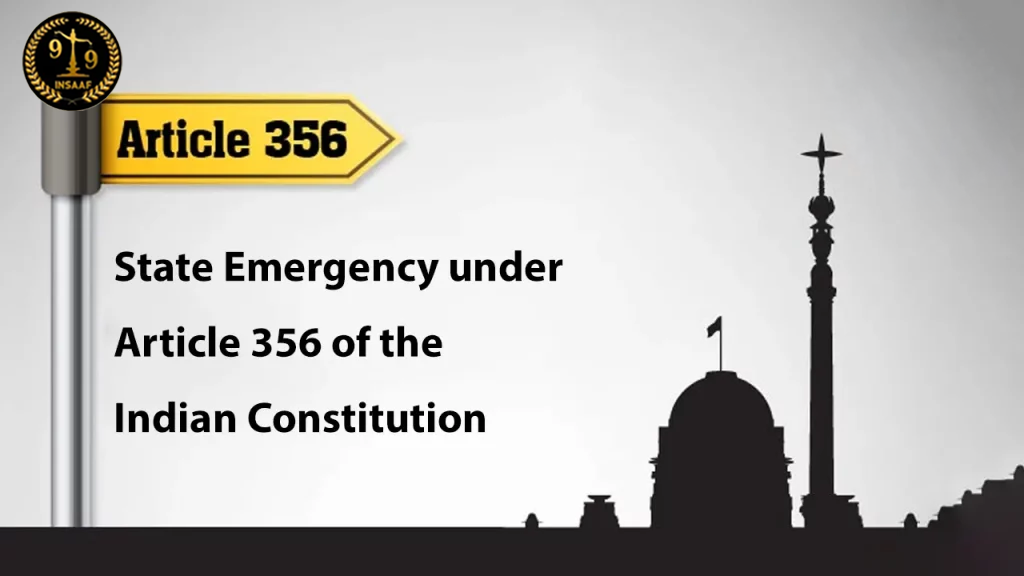

Online Legal Advice from Insaaf99® Online Lawyer Consultation in India


Online Legal Advice from Insaaf99® Online Lawyer Consultation in India

Article 356 stands as a pivotal provision addressing the delicate balance between democracy and the necessity for effective governance in the Indian constitutional framework. Article 356 of the Indian Constitution grants the President the authority to impose President's Rule in a state when the constitutional machinery in that state fails. Since India's independence, this provision has been invoked multiple times, leading to discussions about its efficacy and the possibility of misuse. Let us delve into the nuances of Article 356, examining its historical context, scope, and implications.
Article 356, often referred to as the "Constitutional Atom Bomb," grants the President the authority to assume control of a state's administration if the Governor submits a report asserting the incapacity to govern in line with the constitutional provisions. Rooted in the principles of federalism, this provision seeks to preserve the nation's integrity while addressing crises at the state level.
Article 356 in the Indian Constitution, inspired by British Rule experiences and framed to address provincial breakdowns, seeks to balance central authority and state autonomy. Despite its historical significance, concerns about misuse have emerged over time. Rooted in Section 93 of the Government of India Act, 1935, Article - 356 was retained with modifications to ensure stability and integrity in the newly formed republic.
Also Read: - Understanding Section 138 of Negotiable Instrument Act: Punishments and Implications
Article - 356 comes into play for two primary reasons:
Constitutional Machinery Failure: This occurs when the state government can't operate within constitutional bounds. Reasons may range from political instability to widespread violence or natural calamities.
State Security Threat: If the President deems a serious threat to a state's peace and security, Article 356 allows for the imposition of President's Rule. This threat could arise from internal disturbances, external aggression, or any situation jeopardizing the state's sovereignty.

The invocation of President's Rule under Article - 356 carries profound consequences. Upon activation, the elected state government undergoes a temporary dissolution, placing the state directly under the control of the President.
The utilization of Article 356 is not devoid of controversy. Critics contend that it can be manipulated for political motives, undermining the tenets of federalism and democratic governance. Instances have arisen where Article 356 was seemingly invoked arbitrarily, sparking apprehensions about its potential misuse as a political tool.
To prevent arbitrary use, the Constitution embeds checks and balances for invoking Article 356. Safeguards ensure President's Rule is a last resort, not a political tool.
The 1980s Sarkaria Commission proposed guidelines, emphasizing:
In the landmark Bommai case (1994), the Supreme Court reinforced the Sarkaria Commission guidelines. It established principles, including:
Article 356 requires Parliament's approval within a specified period. This crucial step safeguards against emergency power misuse, subjecting the decision to thorough scrutiny and debate, preventing hasty or politically motivated actions.
Article 356 of the Indian Constitution, while addressing exceptional circumstances, poses federalism risks. Balancing national unity and state autonomy is challenging. Sarkaria Commission guidelines, reinforced by the Bommai case, safeguard against arbitrary use. As India evolves, judicious application is crucial. Ongoing discussions among policymakers, experts, and citizens ensure the provision guards the constitutional order, not political manipulation. Preserving the delicate balance between federalism and effective governance is vital for a strong democratic nation.
Insaaf99, an innovative online legal consultation platform, proves invaluable in Article 356-related cases. With a network of legal experts, it offers prompt and accessible legal advice, aiding individuals and entities navigating complexities surrounding constitutional breakdowns. Insaaf99's user-friendly interface ensures swift assistance, fostering informed decisions and robust legal strategies in the face of challenges arising from the application of Article 356 of the Indian Constitution.